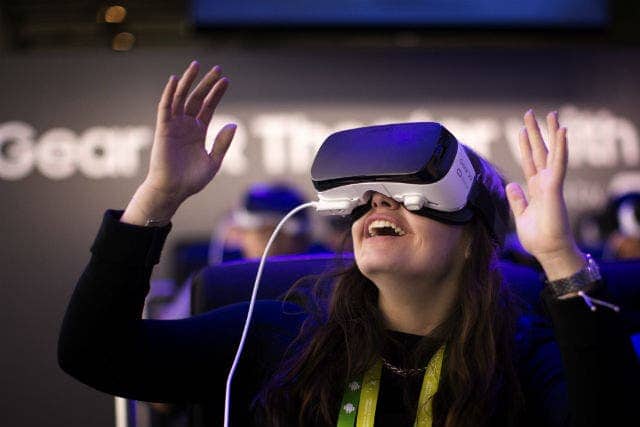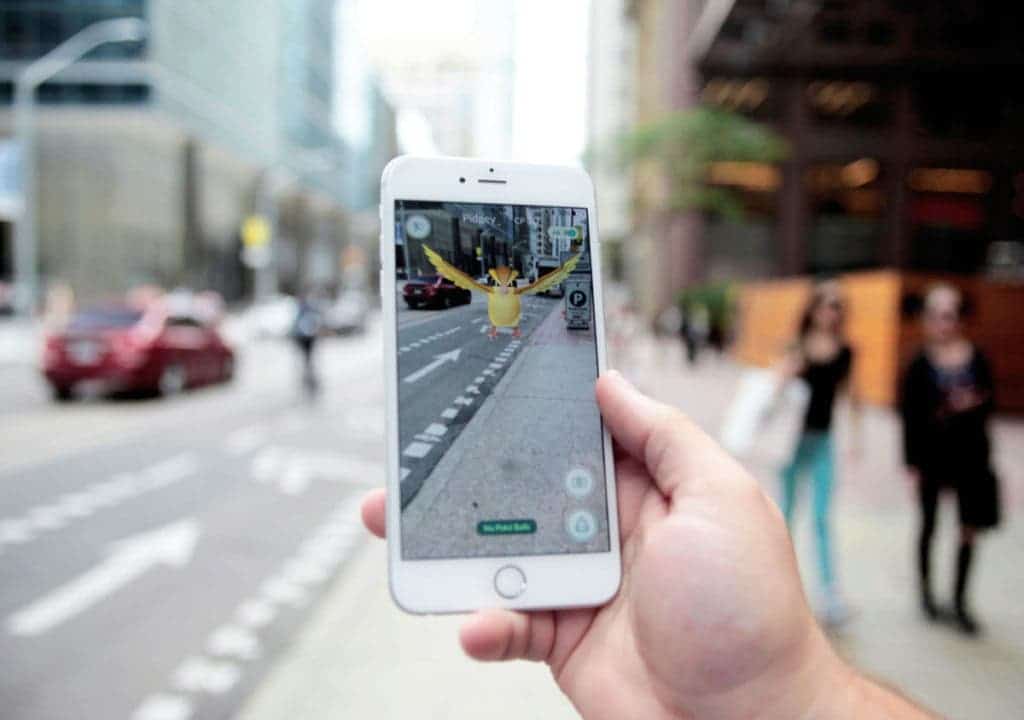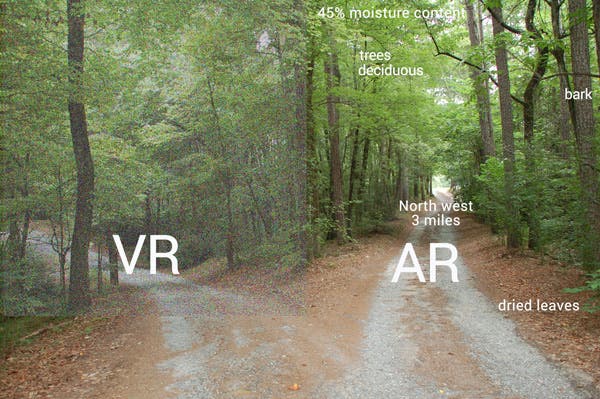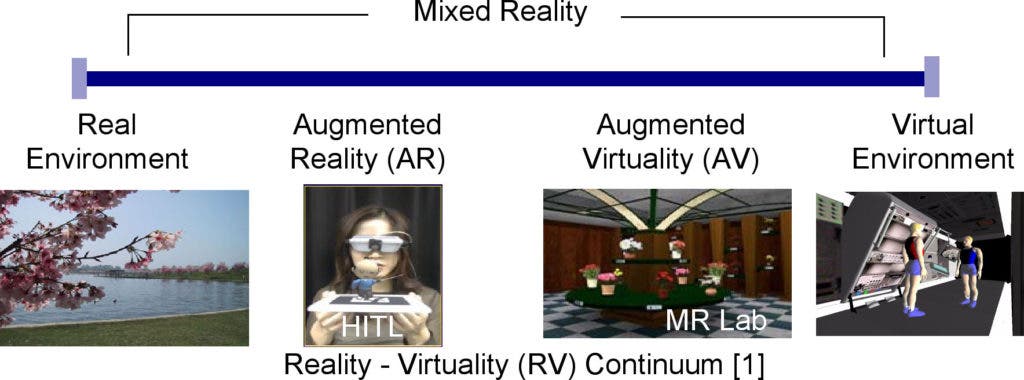Virtual and augmented reality seem to be on everybody’s lips nowadays, both promising to revamp the tech scene and change the way consumers interact in the digital space. Despite the hype and media attention, the two often get confused as some people use the terms interchangeably. While there are many similarities between virtual reality (VR) and augmented reality (AR), the two are definitely distinguishable. Let’s dive into these differences.
What’s Virtual Reality?

Virtual reality is a computer simulated reality in which a user can interact with replicated real or imaginary environments. The experience is totally immersive by means of visual, auditive and haptic (touch) stimulation so the constructed reality is almost indistinguishable from the real deal. You’re completely inside it.
Marked by clunky beginnings, the idea of an alternate simulated reality took off in the late ’80s and early ’90s, a time when personal computer development exploded and a lot of people became excited about what technology had to offer. These attempts, like the disastrous Nintendo Virtual Boy which shut down after only one year, were marked by failure after failure, so everyone seemed to lose faith in VR.
Then came Palmer Luckey, who is undoubtedly the father of contemporary VR thanks to his Oculus Rift. Luckey built his first prototype in 2011, when he was barely 18, and quickly raised $2 million with Kickstarter. In 2014, Facebook bought Oculus Rift for $2 billion. Other popular VR headsets include Samsung Gear VR or Google Cardboard.
What’s Augmented Reality?

While VR completely immerses the user in a simulated reality, AR blends the virtual and real. Like VR, an AR experience typically involves some sort of goggles through which you can view a physical reality whose elements are augmented (or supplemented) by computer-generated sensory input such as sound, video, graphics or GPS data. In augmented reality, the real and the non-real or virtual can be easily told apart.
Wearing Google Glass — the biggest effort a company ever made to bring AR to mass consumers — you can walk through a conference hall and see things ‘pop to life’ around the booths, such as animated 3D graphics of an architecture model if the technology is supported. The goggles aren’t even necessary since you can do this via mobile apps which use a smartphone’s or tablet’s camera to scan the environment while augmented elements will show on the display. There are other creative means, as well.
Unfortunately, Google Glass didn’t take off and the company discontinued the product in 2015. Instead, AR apps on smartphones are much more popular, possibly because they’re less creepy than a pair of glasses with cameras.

Perhaps the most revealing example of AR is Pokemon Go, a viral phenomenon which amassing more than 100 million downloads in a few week. In Pokemon Go, you use your smartphone to find pokemons lurking in your vicinity with the help of a map that’s build based on your real-life GPS signal. To catch the pokemon you have to throw a pokeball at it by swiping on your mobile’s screen and when you toggle AR on, you can see the pokemon with the real world in the background.
Despite the hype, Pokemon GO has a minimal and basic AR interface. Some more revealing examples include:
- Sky Map — a mobile app that lets you point your phone towards the sky and ‘see’ all the constellations you’re facing in relation to your position.
- Word Lens — A Google app that allows you to point your phone to a sign and have it translated in your target language, instantly.
- Project Tango – another Google project which aims to create a sensor-laden smartphone that can map the real world and project an accurate 3D picture of it.
“I’m excited about Augmented Reality because unlike Virtual Reality which closes the world out, AR allows individuals to be present in the world but hopefully allows an improvement on what’s happening presently… That has resonance.”
Tim Cook, CEO, Apple
Virtual reality vs augmented reality

Both technologies
- enrich the experience of a user by offering deeper layers of interactions;
- have the potential to transform how people engage with technology. Entertainment, engineering or medicine are just a couple of sectors where the two technologies might have a lasting impact;
However, the two stand apart because:
- virtual reality creates a completely new environment which is completely computer generated. Augmented reality, on the other hand, enhances experiences through digital means that offer a new layer of interaction with reality, but does not seek to replace it.
- AR offers a limited field of view, while VR is totally immersive.
- Another way to look at it is once you strap those VR goggles, you’re essentially disconnected from the outside world. Unlike VR, an AR user is constantly aware of the physical surroundings while actively engaged with simulated ones.
- virtual reality typically requires a headed mount such as the Oculus Rift goggles while augmented reality is far less demanding — you just need a smartphone or tablet.
What’s sure is we’re just barely scratching the surface of what AR and VR can do. In a report earlier this year, BCC Research estimated the global market for both virtual reality and AR will reach more than $105 billion by 2020, up from a mere $8 billion last year.
If you’re still confused, you can always use a cinematic analogy. For instance, the world of The Matrix corresponds to virtual reality while augment reality is akin to The Terminator. Another way to look at this is to think about scuba diving versus going to the aquarium. In virtual reality, you can swim with sharks and with augment reality you can have shark pop out of your business card through the lens of a smartphone. Each has its own pros and cons, so you be the judge which of the two is better.
Bonus: What’s Mixed Reality?

We just made things pretty clear on what VR and AR are and where the boundary between the two lies. It’s Following innovation in the two fields, a third distinct medium has surfaced: mixed reality (MR).
What MR does is mix the best of augmented and virtual reality to create a … hybrid reality. I confess it gets confusing, partly because the technology is very new and it might innovate itself into something different, but the best explanation I can offer is that mixed reality overlays synthetic content over the real world. If that sounds familiar, it’s because MR is very similar to AR. The key difference here is that in MR the virtual content and the real-world content are able to react to one another in real time. The interaction is facilitated by tools you’d normally see in VR like special goggles and motion sensors used to control.
For the sake of clarity, perhaps the best way to explain MR is to see it in action — enter Microsoft’s Hololens as demoed with Minecraft.


